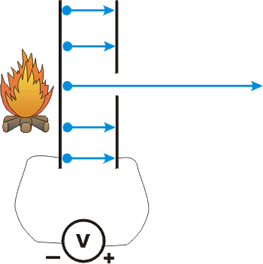| Here are the questions and answers for today's Pre-Class Quiz #7. |
We finished our discussion of the evolution of life on Earth. We ended this with my opinions about what energy sources are correct in principle.
We then talked about the Photoelectric Effect.
I provided some background material, which hopefully will make the material in Chapter 13 even more clear.
Metals are often called conductors, which means they can carry an electric current. You will recall from Class 8 that this means there are electric charges moving inside the metal. It turns out that conductors are materials in which some of the electrons are not bound very strongly to a particular place in the metal, and in fact are not bound very strongly to the metal itself. It is this property that allows the electrons in metals to move, causing an electric current.
You wil also recall from Class 8 that thermal energy is just internal elastic and kinetic energy of the atoms, molecules and electrons of the material. Thus is may not be a surprise to you that if we heat up a metal, some of the electrons on its surface can start vibrating so fast that they actually escape from the surface. This process is called thermionic emission.
Normally, when the negatively charged electron "boils" off the surface of the metal, it leaves a net positive charge on the surface. This attracts the electron back onto the surface, so these thermionic electrons typically only get a fraction of a millimeter away from the surface before the fall back into it.
In the figure, we are heating up the left hand plate so thermionic electrons will be boiled off the surface. But because of the voltage difference being maintained across the plate by a battery, electrons that boil off between the two plates do not fall back into the plate, but instead are attracted to the right hand positive plate. Most of the electrons crash into the positive plate, as shown. However, the electron in the middle would have crashed into the plate except that we have cut a hole in that part of it. So we get a beam of electrons out of this "electron gun." In real electron guns, such as at the back of a conventional TV picture tube, the negative plate is not heated with a campfire as in our figure. Instead, a small filament of wire has a current passed through it. The filament heats up, glows red, and heats up the negative plate. You may have seen that red glow in the back of a TV picture tube. |
 |
| We asked three questions in class. Here is a link to the questions and your answers. | |
| Here is a link to today's Journal. |